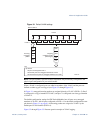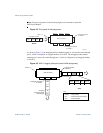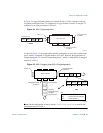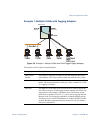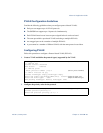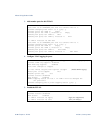
Alteon OS Application Guide
Chapter 3: VLANs
8742C4911, January 2007
Protocol-based VLANs
Protocol-based VLANs (PVLANs) allow you to segment network traffic according to the net-
work protocols in use. Traffic generated by supported network protocols can be confined to a
particular port-based VLAN. You can give different priority levels to traffic generated by dif-
ferent network protocols.
With PVLAN, the switch classifies incoming packets by Ethernet protocol of the packets, not
by the configuration of the ingress port. When an untagged or priority-tagged frame arrives at
an ingress port, the protocol information carried in the frame is used to determine a VLAN to
which the frame belongs. If a frame’s protocol is not recognized as a pre-defined PVLAN type,
the ingress port’s PVID is assigned to the frame. When a tagged frame arrives, the VLAN ID in
the frame’s tag is used.
Each VLAN can contain up to eight different PVLANs. You can configure separate PVLANs
on different VLANs, with each PVLAN segmenting traffic for the same protocol type. For
example, you can configure PVLAN 1 on VLAN 2 to segment IPv4 traffic, and PVLAN 8 on
VLAN 100 to segment IPv4 traffic.
To define a PVLAN on a VLAN, configure a PVLAN number (1-8) and specify the frame type
and the Ethernet type of the PVLAN protocol. You must assign at least one port to the PVLAN
before it can function. Define the PVLAN frame type and Ethernet type as follows:
Frame type—consists of one of the following values:
Ether2 (Ethernet II)
SNAP (Simple Network Access Protocol)
LLC (Logical Link Control)
Ethernet type—consists of a 4-digit (16 bit) hex value that defines the Ethernet type. You
can use common Ethernet protocol values, or define your own values. Following are
examples of common Ethernet protocol values:
IPv4 = 0080
IPv6 = 86dd
ARP = 0806





